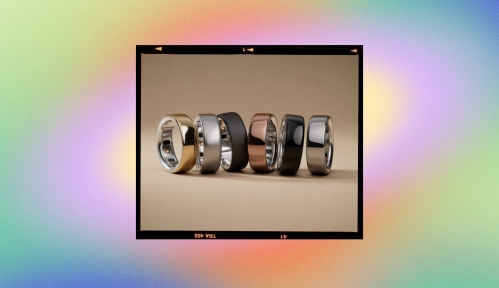Call it glistening, call it glowing, there’s one thing most athletes have in common: sweat. No matter if you’re the star of your spin class or live for a powerlifting sesh, sweating is a crucial function that helps to regulate your body’s core temperature.
Experts in This Article
a registered dietitian who specializes in nutrition coaching for endurance athletes
a registered dietitian who specializes in sports nutrition, exercise physiologist, and the director of performance nutrition at UPMC Sports Medicine
athletic trainer and director of the Hydration, Exercise, and Thermoregulation (HEAT) Laboratory at University at Buffalo
But have you ever wondered what kind of sweat your body produces? The answer, particularly if you have salty sweat, might change the way you prepare, exercise, and recover from any workouts you have on the books.
“Sweat is mostly water but also contains electrolytes [consisting of] primarily sodium, chloride, and potassium,” says Riana Pryor, PhD, ATC, athletic trainer and director of the Hydration, Exercise, and Thermoregulation (HEAT) Laboratory at University at Buffalo. “Individuals who excrete excessive sodium in their sweat are commonly termed ‘salty sweaters.’”
So, how can you figure out what kind of sweat you have? Ahead, experts share signs you might be a salty sweater, what to do about it, and more.
First things first: Why is it important to know what kind of sweat you produce?
Sweat is a natural process to keep your body cool. The type of sweat your body produces, however, depends on a range of factors.
“Genetics, training, acclimatization, nutrition, clothing, and environment will all contribute to how an individual sweats,” says Michael DiBiasi, RD, CSSD, ACSM-EPC, a registered dietitian who specializes in sports nutrition, exercise physiologist, and the director of performance nutrition at UPMC Sports Medicine.
Understanding your sweat type can help you optimize your workouts and exercise recovery—and keep you safe. If you err on the side of being a salty sweater, you might need to reframe your hydration plans before, during, and after a workout, especially if you plan to exercise outdoors or in hot and humid conditions (more on this later!).
“Understanding your specific ‘sweat rate and make up’ allows you to better prepare, endure, and recover from exercise or activities that cause you to produce a lot of heat,” DiBiasi says.
Why is my sweat so salty?
Salty sweat can be a signal that something else going on with your body or workout conditions.
“You may be more likely to have salty sweat at the beginning of the summer before your body has adapted to the heat,” Pryor says. “It can also be caused by taking certain medications, such as anxiety medications or antidepressants, or having conditions such as cystic fibrosis.”
As with any health concerns, be sure to check in with your doctor to address your questions and needs.
As Pryor mentioned above, sweat contains valuable electrolytes, which are a key component to staying hydrated and keeping your body functioning efficiently. Regardless if your perspiration is “salty,” when electrolytes aren’t replenished, an electrolyte imbalance may occur, according to the Cleveland Clinic. Electrolyte imbalances can result in a range of symptoms including muscle cramps and spasms, irregular heart rate, and nausea.
If you’re a heavy sweater, you might be more prone to experience these symptoms, making it that much more crucial to understand what kind of sweat you have.
“Someone who’s a heavy sweater who doesn’t drink enough could be at greater risk for faster fatigue, increased heart rate, and heat illness,” DiBiasi says.
As such, determining what type of sweat you produce can help you prepare for any range of workouts you might have in your sights.
“Active individuals who exercise for longer durations and/or in warmer conditions must be able to replenish fluid and electrolyte losses adequately,” says Alex Larson, RD, a registered dietitian who specializes in nutrition coaching for endurance athletes.
“Genetics, training, acclimatization, nutrition, clothing, and environment will all contribute to how an individual sweats.” —Michael DiBiasi, RD, CSSD, ACSM-EPC
4 signs you have salty sweat
So, how can you determine if you have salty sweat? More below.
1. Your sweat tastes salty
While you might not jump at the chance to season your dinner with a side of sweat, the sodium levels in your perspiration can cause it to taste extra savory. Chances are, if you’ve tasted your sweat and it’s salty, you’re probably a salty sweater, according to the experts. In fact, Pryor, Diabisi, and Larson all agree this is one of the most common ways to tell you’re producing salty sweat.
“If you notice you taste very salty, that’s a good indication you’re losing a lot of fluid quickly and not able to hold in the sodium— the element that’s part of salt that regulates fluid balance in the body well,” DiBiasi says.
2. Your post-workout clothes are crusty
Throughout your workout, your body perspires, calling on your clothes to help absorb or wick away sweat. If you’ve noticed your clothes tend to be extra crispy when they hit the laundry bin, this might signal your body is expelling salty sweat, according to the experts.
When you’re working out, your body sweats to cool down, Pryor says. When the water in your sweat evaporates, it can leave behind other elements, namely sodium.
“Salty sweaters usually have white, crusty lines on their clothes, face, or arms following prolonged exercise, such as road races and triathlons,” Pryor says. “These lines are sodium dried on the skin or clothes that accumulate throughout the exercise. You’re more likely to see the lines if you are exercising in a hot environment or exercising at a high intensity since these things cause you to sweat more profusely.”
This dried sweat can collect in high-sweat zones, according to DiBiasi.
“You can easily have [leftover sodium] in heavy sweat areas of your clothes like armpits, neck and bra lines, upper back, and even shoelaces,” he says.
3. You have body cramps
As mentioned above, salty sweat tends to carry higher electrolyte levels. When your body loses enough electrolytes to cause an imbalance, you can experience a range of uncomfortable—and at times, dangerous—symptoms.
You might “experience chronic cramping issues during or post-exercise, or feel faint or extreme weakness after exercise,” Larson says. This is where nutrition and hydration planning can be fundamental—but more on that in a bit!
4. You crave salty foods during or after exercise
Your body can be a wonderful training partner—it can tell you what it needs to function at its best. Just like it’s important to replenish your protein and carbs after an intense workout, it can be crucial to re-up your hydration and sodium levels, too.
If you notice you regularly crave salty foods—even while you’re in the middle of exercise—it might be a sign that you have low sodium levels or that you have salty sweat.
“You may also crave salty foods during or after exercise, which can be a sign of large sweat and sodium losses,” Pryor says.
What to do if you have salty sweat
If you’ve determined you have salty sweat, there are simple tactics and methods you can fold into your normal training and fueling routine.
First, take into account what type of exercise you intend to do to help prep ahead. If you have a low-key workout on the books like basic yoga, weightlifting, walking, or light daily activities, standard hydration including water and electrolyte drinks will generally suffice to replenish any lost electrolytes, according to DiBiasi.
Meanwhile, longer or more intense workouts—especially outdoors in hot or humid conditions—will require a little more planning and hydrating while you’re on the go.
“The longer and more intense the workout, the more you’re going to be sweating and the more important it is to prep and plan your hydration and electrolyte strategy,” Larson says. “Before workouts, you’ll want to consume fluids to establish an adequate hydration status. A great way to monitor hydration is by urine color, aiming for pale yellow in color.”
When you’re in the middle of the workout, stick to your hydration plan, even if you’re not feeling especially thirsty because “as exercise intensity and volume continue and increase, the thirst mechanism can get blunted, leading to less and less fluid intake,” DiBiasi says.
During your workout, you’ll want to consume 5 to 10 ounces of electrolyte-rich fluids every 15 to 20 minutes to prevent dehydration and avoid overhydration, according to Larson. Your doctor or registered dietitian can help customize a hydration plan specific to your needs.
Once your workout is finished, renew your hydration and electrolytes.
“For athletes who exercise frequently or for long durations, it’s important to replenish the sodium and electrolytes lost through sweat by regularly consuming enough salt,” Larson says. “This can be achieved through including an electrolyte product in your water bottle or by including salty foods in your diet. If you have high blood pressure, it’s crucial to work with your doctor regarding a recommended salt intake.”
If you’re eager to learn more about your hydration needs, Larson and DiBiasi recommend doing a sweat test conducted by licensed experts to gain more personalized insights. This can be done by a trained sports dietitian in a lab setting, according to DiBiasi. During a programmed exercise routine, a sports dietitian can determine your total body fluid loss, total sodium loss, and prescribe a specific hydration protocol for you, he says.
“There are sweat testing options available on the market that will share more information about the electrolyte content of your sweat,” Larson says. “If you’re having chronic issues, it may be time to learn more about your sweat rate to dial in your hydration and electrolyte strategy.”
Sign Up for Our Daily Newsletter
Get all the latest in wellness, trends, food, fitness, beauty, and more delivered right to your inbox.
Got it, you've been added to our email list.











